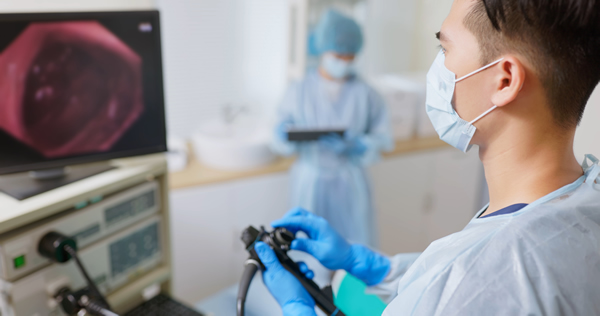
Anal cancer is a form of cancer that begins in the tissues at the end of the large intestine and the outer layers of skin in the anus. Like many forms of cancer, early detection is key to successful treatment outcomes in anal cancer.
When caught in its initial stages, anal cancer is much more manageable and can often be treated effectively with minimally invasive methods. The goal of early detection is to identify abnormal changes in the cells of the anal canal before they develop into cancer, or to catch cancer at its earliest and most treatable stage.
“Look, I get it. Talking about your backside isn’t exactly dinner conversation,” said Southern Cancer Center Medical Oncologist Dr. Michael Meshad. “But catching anal cancer early can save your life. Don’t let embarrassment keep you from a simple screening.”
Who Can Benefit from Screening for Anal Cancer?
While there is no recommended screening for anal cancer for the general population, tests for anal cancer do exist and may be recommended for some people. If you are at an increased risk of developing anal intraepithelial neoplasia (AIN), a potentially precancerous condition, or anal cancer, your healthcare provider may recommend screening.
While it’s important to remember anyone can develop anal cancer, the most common risk factors include:
- Human Papillomavirus (HPV) Infection: Many anal cancers are connected to certain types of HPV infections.
- Anal Warts: While anal warts themselves are not cancerous, their presence can indicate an HPV infection or potential for precancerous conditions.
- Sexual Activity: Receptive anal intercourse and having multiple sexual partners can increase anal cancer risk.
- Weakened Immune System: Conditions like HIV/AIDS or immunosuppressive medications from organ transplants can elevate risk levels.
- Smoking: Tobacco use is a known risk factor for many cancers, including anal cancer.
Screening guidelines can vary based on individual risk factors. If you have concerns about your risk level, your healthcare provider can work with you to design a personalized screening strategy based on your specific needs.
What Tests Are Used to Find Anal Cancer?
Multiple tests can be used to detect anal cancer. Here are the key screening techniques recommended for early detection of anal cancer:
Anal Pap Test:
Some people with certain risk factors may benefit from screening with a regular anal cytology test. This is also called an anal Pap test or anal Pap smear because it is similar to a Pap test for cervical cancer. Cells are collected from the anal canal and looked at closely in a lab. Further testing with a digital rectal examination or an anoscopy may be recommended. If the anal Pap test finds an abnormality, a biopsy may also be recommended.
Some experts recommend that at-risk people who are HIV-positive receive screening with an anal Pap test every year, while those who are HIV-negative may be screened every two to three years. The benefits of this screening are still being studied, and there is no widespread agreement on the best screening schedule. Ask your healthcare provider if you have any questions.
Digital Rectal Examination (DRE):
A healthcare provider uses a lubricated, gloved finger to feel for lumps or abnormalities in the anal canal and rectum. They will also check for abnormalities in the groin area. If any problems or abnormal changes are found, your provider may refer you to a specialist for additional testing.
Anoscopy:
Anoscopy is a medical procedure that involves the examination of the anal canal and the lower rectum using a small, tubular instrument called an anoscope. An anoscope is about three to four inches long and about an inch in diameter. It will sometimes have a light on the end of it. This procedure is typically performed in a doctor’s office and is relatively quick and minimally invasive. The anoscope provides a clear view of the anal lining, allowing healthcare professionals to identify any abnormal growths, lesions, or signs of disease.
If abnormalities are discovered during an anoscopy, your provider may refer you to further testing with a biopsy.
Endoscopy:
Similar to anoscopy, endoscopy is a procedure that uses a thin, flexible tube with a light and small camera attached to look inside a part of the body. The most common type of endoscopy used for anal cancer testing is called a colonscopy, which can look at the anus, rectum, and entire colon.
What to Expect if Abnormalities are Found in Your Anal Cancer Screening
If an abnormal change is found during a screening for anal cancer, your provider will most likely recommend a biopsy for further testing. A biopsy takes a tissue sample from the suspicious area. This sample is then looked at in a lab to determine if there are cancer cells.
During a biopsy, anesthesia may be used to numb the area before a small piece of tissue is cut out. If the affected area is small, they may try to remove the entire abnormality.
If cancer is detected in the sample, you will receive a report with information about the cancer, including whether it is linked to an HPV infection.
Ask Your Healthcare Provider for More Information about Anal Cancer Screening
If you are at a higher risk for developing anal cancer, screening may be an important part of preventative healthcare. Discussing your risk level and screening options with your healthcare provider is a proactive measure for your health.
If you have been recently diagnosed with anal cancer and would like to make an appointment, call our office at (251) 625-6896 or visit online at SouthernCancerCenter.com to schedule an appointment.

